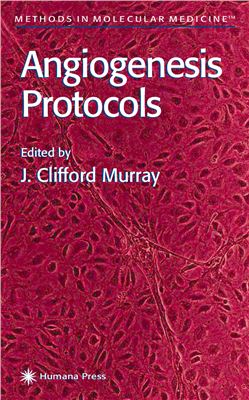Humana Press. (2001). pp 300, hardcover ISBN: 0-89603-698-7
This reference book addresses the burgeoning field of angiogenesis and anti-angiogenesis and the methods for investigating this process. It consists of a series of distinct chapters on a variety of different techniques in cell culture, in situ and truly in vivo. The chapters provide detailed laboratory protocols for investigating angiogenesis both as a whole process and the mechanisms underlying the process. The book provides a valuable resource for scientists moving into the angiogenesis field, and a useful guide to (hose already in the field wishing to expand their technical base. Some of the techniques described are elegantly simple and fairly easy to scl up, olhers arc likely to take significantly more investment in time and equipment. These latter chapters are likely to be useful to assess whether these approaches are applicable to any particular investigators needs, but I would imagine a trip to visit laboratories where they are taking place would be additionally required.
The book covers four different in vitro assays - endothelial sprouting in collagen gels and matrigcls, migration of endothelial cells out of aortic rings, and chemokincsis in 3D matrices. It is surprising that the most basic assays-HUVKC cell proliferation assay (either using BrDU or 3H) and the scratch assay arc nol described in detail here. Nine different in vivo assays are described varying from the extremely simple to the most complex. The simple assessment of angiogenesis in tumours is described, followed by a variety of gel based in vivo assays (matrigel, alginate, two subcutaneous sponge disk assays and a hollow fibre assay are all described in detail. The most elegant, and hence complicated protocols are those describing chambers in adult or juvenile tissue, particularly the dorsal skinfold chamber the rabbit eyepocket and the chick chorioallantoic membrane assay. All three of these are classic well described and powerful techniques. As such most (although not all) of the principal techniques used in angiogenesis research are covered.
This reference book addresses the burgeoning field of angiogenesis and anti-angiogenesis and the methods for investigating this process. It consists of a series of distinct chapters on a variety of different techniques in cell culture, in situ and truly in vivo. The chapters provide detailed laboratory protocols for investigating angiogenesis both as a whole process and the mechanisms underlying the process. The book provides a valuable resource for scientists moving into the angiogenesis field, and a useful guide to (hose already in the field wishing to expand their technical base. Some of the techniques described are elegantly simple and fairly easy to scl up, olhers arc likely to take significantly more investment in time and equipment. These latter chapters are likely to be useful to assess whether these approaches are applicable to any particular investigators needs, but I would imagine a trip to visit laboratories where they are taking place would be additionally required.
The book covers four different in vitro assays - endothelial sprouting in collagen gels and matrigcls, migration of endothelial cells out of aortic rings, and chemokincsis in 3D matrices. It is surprising that the most basic assays-HUVKC cell proliferation assay (either using BrDU or 3H) and the scratch assay arc nol described in detail here. Nine different in vivo assays are described varying from the extremely simple to the most complex. The simple assessment of angiogenesis in tumours is described, followed by a variety of gel based in vivo assays (matrigel, alginate, two subcutaneous sponge disk assays and a hollow fibre assay are all described in detail. The most elegant, and hence complicated protocols are those describing chambers in adult or juvenile tissue, particularly the dorsal skinfold chamber the rabbit eyepocket and the chick chorioallantoic membrane assay. All three of these are classic well described and powerful techniques. As such most (although not all) of the principal techniques used in angiogenesis research are covered.

